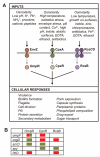Characterization of combinatorial patterns generated by multiple two-component sensors in E. coli that respond to many stimuli
- PMID: 21246512
- PMCID: PMC3413328
- DOI: 10.1002/bit.22966
Characterization of combinatorial patterns generated by multiple two-component sensors in E. coli that respond to many stimuli
Abstract
Two-component systems enable bacteria to sense changes in their environment and adjust gene expression in response. Multiple two-component systems could function as a combinatorial sensor to discriminate environmental conditions. A combinatorial sensor is composed of a set of sensors that are non-specifically activated to different magnitudes by many stimuli, such that their collective activity pattern defines the signal. Using promoter reporters and flow cytometry, we measured the response of three two-component systems in Escherichia coli that have been previously reported to respond to many environmental stimuli (EnvZ/OmpR, CpxA/CpxR, and RcsC/RcsD/RcsB). A chemical library was screened for the ability to activate the sensors and 13 inducers were identified that produce different patterns of sensor activity. The activities of the three systems are uncorrelated with each other and the osmolarity of the inducing media. Five of the seven possible non-trivial patterns generated by three sensors are observed. This data demonstrate one mechanism by which bacteria are able to use a limited set of sensors to identify a diverse set of compounds and environmental conditions.
Copyright © 2010 Wiley Periodicals, Inc.
Figures





Similar articles
-
Transmembrane signal transduction by the Escherichia coli osmotic sensor, EnvZ: intermolecular complementation of transmembrane signalling.Mol Microbiol. 1994 Aug;13(3):435-44. doi: 10.1111/j.1365-2958.1994.tb00438.x. Mol Microbiol. 1994. PMID: 7997160
-
Involvement of EnvZ-OmpR two-component system in virulence control of Escherichia coli in Drosophila melanogaster.Biochem Biophys Res Commun. 2013 Aug 23;438(2):306-11. doi: 10.1016/j.bbrc.2013.07.062. Epub 2013 Jul 22. Biochem Biophys Res Commun. 2013. PMID: 23886953
-
MzrA-EnvZ interactions in the periplasm influence the EnvZ/OmpR two-component regulon.J Bacteriol. 2010 Dec;192(23):6271-8. doi: 10.1128/JB.00855-10. Epub 2010 Oct 1. J Bacteriol. 2010. PMID: 20889743 Free PMC article.
-
Signal transduction and gene regulation through the phosphorylation of two regulatory components: the molecular basis for the osmotic regulation of the porin genes.Mol Microbiol. 1990 Jul;4(7):1077-82. doi: 10.1111/j.1365-2958.1990.tb00681.x. Mol Microbiol. 1990. PMID: 1700256 Review.
-
Engineering bacterial signals and sensors.Contrib Microbiol. 2009;16:194-225. doi: 10.1159/000219381. Epub 2009 Jun 2. Contrib Microbiol. 2009. PMID: 19494587 Review.
Cited by
-
Nutrient depletion may trigger the Yersinia pestis OmpR-EnvZ regulatory system to promote flea-borne plague transmission.Mol Microbiol. 2019 Nov;112(5):1471-1482. doi: 10.1111/mmi.14372. Epub 2019 Sep 13. Mol Microbiol. 2019. PMID: 31424585 Free PMC article.
-
Foundations for the design and implementation of synthetic genetic circuits.Nat Rev Genet. 2012 May 18;13(6):406-20. doi: 10.1038/nrg3227. Nat Rev Genet. 2012. PMID: 22596318 Review.
-
Contribution of the Locus of Heat Resistance to Growth and Survival of Escherichia coli at Alkaline pH and at Alkaline pH in the Presence of Chlorine.Microorganisms. 2021 Mar 28;9(4):701. doi: 10.3390/microorganisms9040701. Microorganisms. 2021. PMID: 33800639 Free PMC article.
-
Expression of the AcrAB Components of the AcrAB-TolC Multidrug Efflux Pump of Yersinia enterocolitica Is Subject to Dual Regulation by OmpR.PLoS One. 2015 Apr 20;10(4):e0124248. doi: 10.1371/journal.pone.0124248. eCollection 2015. PLoS One. 2015. PMID: 25893523 Free PMC article.
-
Alkali metals in addition to acidic pH activate the EvgS histidine kinase sensor in Escherichia coli.J Bacteriol. 2014 Sep;196(17):3140-9. doi: 10.1128/JB.01742-14. Epub 2014 Jun 23. J Bacteriol. 2014. PMID: 24957621 Free PMC article.
References
-
- Ache BW, Young JM. Olfaction: Diverse species, conserved principles. Neuron. 2005;48(3):417–430. - PubMed
-
- Aiba H, Mizuno T, Mizushima S. Transfer of phosphoryl group between two regulatory proteins involved in osmoregulatory expression of the ompF and ompC genes in Escherichia coli. J Biol Chem. 1989;264(15):8563–8567. - PubMed
-
- Anderson JC, Clarke EJ, Arkin AP, Voigt CA. Environmentally controlled invasion of cancer cells by engineered bacteria. J Mol Biol. 2006;355(4):619–627. - PubMed
-
- Arricau N, Hermant D, Waxin H, Ecobichon C, Duffey PS, Popoff MY. The RcsB–RcsC regulatory system of Salmonella typhi differentially modulates the expression of invasion proteins, flagellin and Vi antigen in response to osmolarity. Mol Microbiol. 2002;29:835–850. - PubMed
Publication types
MeSH terms
Substances
Grants and funding
LinkOut - more resources
Full Text Sources

